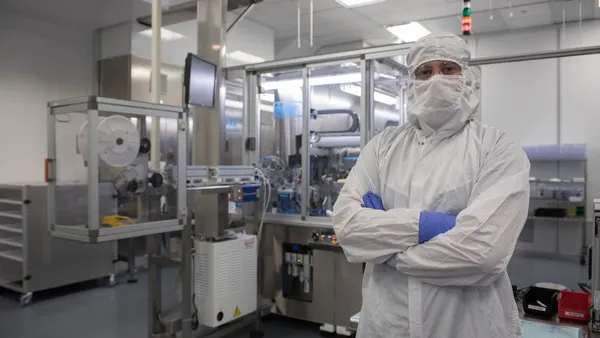Keeping Pace with Project Data
Parexel Reinvents Technology to Fit New Development Landscape
Drug development is a complex journey. To aid pharmaceutical companies in navigating this complex landscape, Parexel created a brand new version of its technological solution, Liquent Insight 6.0, which was originally launched in 2004.
Parexel’s Liquent was born out of many direct conversations with customers to address common challenges when it comes to standardizing project data to adhere to legislative requirements. Parexel built the 6.0 version of the technology solution around new modules designed to solve particular client needs, with the goal of providing advanced analytics to address evolving regulations.
Parexel built out these new modules to support the entire regulatory product lifecycle, from early planning of registration targets through product retirement, thus providing the tools needed to more quickly bring treatments to market.
Usability proved to be the key to creating and shaping the new system so it would apply to each specific user.
According to Parexel, Liquent Insight 6.0 is the only end-to-end, integrated RIM platform that delivers submission planning, publishing, viewing, and registration management to support the lifespan of products. Liquent Insight 6.0 makes navigating the global regulatory landscape easier, helping to significantly reduce drug development timelines and processes with the goal of bringing more innovative products to market and getting new treatments to patients faster.
Mobile CRM Solution
Synergistix’s CATS Express Improves Field-Based Interactions
After in-depth competitive research proved that a CRM solution for life-sciences companies would fill an unmet need, Synergistix developed the Customer Analysis and Targeting System (CATS) software suite — an industry game-changer. The CATS software suite combines field-based data capture with management reporting to deliver a state-of-the-art, PDMA-compliant solution for automating, managing, and monitoring salesforce activity.
Last year, Synergistix launched the most recent member of its CATS suite, called CATS Express, a smartphone version of its CRM solution.
With an easy-to-use interface, this allows field-based users to capture and record interactions with healthcare professionals and institutions quickly and accurately when laptops or tablets are unavailable. CATS Express enables sales, clinical, and other life-science teams to use any smartphone, including Apple and Android phones, to view practitioner profiles, quickly record calls or visits, and capture PDMA/Part 11- compliant electronic signatures for sample transactions.
The company also recently announced a strategic partnership with MedPro Systems, a healthcare licensing solution for pharmaceutical and device industries. The partnership allows users to access and validate practitioners’ state licenses in real-time, directly from within the Synergistix CRM application.
Eyes on the (Social Media) Page
Telerx’s Social Monitoring Solution Advances Digital Efforts
Today, the customer chooses how, when, and where to engage with a brand. When the where is the social media space, the industry has been shy about participating, presumably due to risks and lack of hardened social media regulations. Social InteraXions by Telerx enables clients to take advantage of social media through allowing its Brand Ambassadors to do the heavy lifting. Ambassadors have “eyes on the page"— meaning Twitter, Facebook, Pinterest, etc., 24/7 to monitor what customers are saying and feeling about the brand. Using social media as a perpetual focus group, Social InteraXions is structured to take social media participation to the long-awaited next level. It consists of a unique model built upon a foundation of proprietary monitoring techniques and expert interaction by healthcare social media specialists.
Telerx’s social media services are moving the industry forward. While pharma may be new to this space, Telerx is not; the company cut its teeth on social customer care in the consumer goods industry. Telerx’s Social InteraXions solution supports both patients and manufacturers. Studies have shown that information that patients and caregivers find through social media influences decisions they make about their health, including which medications they take and treatments they seek. And patients are now looking for pharmaceutical companies to provide information and support services through social channels, including discounts, customer service, treatment reminders, and information about medications. These are opportunities where pharmaceutical and device manufacturers are uniquely suited to educate, interact, and provide support to their patient populations.
Telerx has the capability to manage both contact center and social media programs within an integrated model, providing the complete voice of the healthcare consumer.
The overall impact of this solution is that pharmaceutical companies will feel at ease using social media as a way to represent the human side of their R&D efforts to produce medications that are beneficial to society. They will begin to provide more patient education, while still remaining within FDA social guidelines, and will reach directly out to those that are posting potential adverse events and product quality complaints to direct them to a private source that may be able to provide the appropriate follow-up. This social communication change in behavior will lead to more open and honest dialogue between manufacturers and the patient community, and ultimately to a more healthy and vibrant society.
Extreme Targeting through Programmatic Technology
Publicis Health’s AOD Leverages the Power of Health-Centric Data
Publicis Health Media and VivaKi worked together to create the Audience On Demand (AOD) Health suite, which allows brands to deliver keenly targeted messages to customized audiences across display, video, mobile, native, and social media. AOD wraps proprietary technology and engineering expertise around the world’s most respected technology and data platforms from companies such as Google, Turn, Videology, 4C, and Blue Kai to create truly differentiated offers. As healthcare and pharmaceutical advertisers place increased precedence on facilitating meaningful and highly relevant interactions with patients, AOD Health is poised to leverage the power of health-centric data, while never breaching the sensitivities of consumer privacy. Case in point, earlier this year, as part of a Boston Consulting Group study, Performics, a ZenithOptimedia agency, and VivaKi tested how using advanced targeting techniques enabled by a DoubleClick unified stack compare with using standard targeting techniques. According to a video release of the project, the results favored advanced targeting techniques: cost per order went down 48%, cost per click decreased 48%, and click through rates increased 25%, as cost per view decreased 26%.
This health-centric first-in-class programmatic service-centered approach combines VivaKi’s addressable media capability with Publicis Health Media’s healthcare specific digital media planning and buying expertise.
This product provides clients access to premium inventory, data, and technology partnerships, while addressing healthcare and pharmaceutical nuances like brand safety and medical regulatory compliance requirements. It helps clients to maintain control of how they are reaching their consumers and where.
The Power of Crowd Testing In The Cloud
Cognizant’s Fastest Service Delivers End-to-End Nonfunctional Testing Capabilities
Fastest — as in fast test — Cognizant’s cloud-based, on-demand software testing service offers companies a quick turnaround by tapping into the company’s software testing practice housing about 30,000 quality assurance professionals. Effective testing requires a large number of intuitive as well as esoteric test scenarios. Unlike traditional functional testing techniques, crowd testing provides insights and delves into undiscovered realms of software testing that traditional testing may not offer.
Fastest recently helped a California-based company find relevant answers in its quest to develop a perfect app for patients with diabetes. The company approached Cognizant with a need to evaluate the performance of its blood glucose level monitors and its integration with smart devices hosting iOS and Android operating systems. The primary goal was to confirm that data transmitted from the meters to the app were accurate so that the correct medical diagnosis could be made.
Fastest to the rescue: the Fastest team gathered 30 participants chosen by an in-built algorithm that analyzed them for the best-fit needed based on skill level, domain, demography, location, smart devices owned, etc. Crowd testers were engaged for arbitrary test scenarios including data stuffing and Web synchronization. They observed the optimal functioning of the app features such as its user interface, display, and other operational aspects — more importantly to check if the information was being captured between devices accurately or not. After three days of collaborative testing, the group unearthed 161 observations, 102 of which were approved by the client. Some of the observations were crucial to the app’s success and could have been discovered only through the collaborative environment.
Cognizant’s process accomplished a feat in three days that would have taken much longer using traditional methods.
Interactive Electronic Decision Tools For Clinical Trials
RTI International Improving Informed Consent Practice
The more informed patients are, the more likely they will complete a clinical trial. To achieve the goal of keeping patients informed, RTI International is developing an interactive, electronic decision tool to help patients better understand trials and what they involve. The tool provides information required by Institutional Review Boards to obtain informed consent in an engaging way. Currently, the tool is tailored to individuals with developmental disabilities (fragile X syndrome).
RTI will soon conduct a randomized controlled trial to compare the efficacy of the interactive electronic decision aid with the typical informed consent practice. The trial will examine how providing information via the decision tool impacts outcomes, such as user knowledge, attitudes, and intended behaviors, including a patient’s likelihood of participating in a trial. RTI plans to submit a manuscript to submit to a peer-reviewed journal describing the development and testing process.
This first-of-its-kind tool is an essential step in capitalizing on the benefits of technology to empower patients and promote meaningful engagement. With future modifications, the tool could easily expand to address clinical trials for drugs for individuals with developmental disabilities and chronic conditions, such as autism or cancer.
RTI’s informed decision making tool could help address the recruitment problem and provide added value by focusing on more informed decisions about trials, and enabling remote enrollment, or at least electronic dissemination of information before a clinical visit.
The federal Agency for Health Care Research and Quality (AHRQ) developed a paper-based informed consent toolkit to address consent form concerns.
RTI seized the opportunity to take this a step further into the digital realm to develop a computer-based, interactive tool written at a low-grade reading level, taking into considerations principles of plain language, clear communication, and health literacy.
The breakthrough moment occurred when a team of design thinking researchers and content experts came together to generate a proposal to the National Institutes of Health (NIH). RTI has made further advances from information gathered when conducting testing with members of the target audience.
Biosimilars in the Bag
TPI’s Pioneering Manufacturing Process Cuts Costs
At a time when the cost of developing biologics continues to soar, Therapeutic Proteins International, a fully integrated manufacturer of biosimilar recombinant protein products, has found a way to cut costs and speed innovation by using the equivalent of a big plastic bag.
TPI Founder Sarfaraz Niazi, Ph.D., experimented with an actual Ziploc bag and discovered that using a soft bag accelerated bacteria growth at a faster rate than the traditional steel containers. This method drastically reduces manufacturing costs and products can be produced more quickly. The innovation includes a single-use bioreactor that is suitable for both mammalian and bacterial expression systems. It contains a proprietary sparging system with orbital shaker that provides a gentle environment for consistent, high-quality cell growth. With more than 30 patents filed, this ISO 7 bioreactor allows for simultaneous development and fast, flexible scale-up.
The biggest value is the ability to produce these products in a more cost-effective manner while maintaining quality. Additionally, if appropriate, tech transfer is much less onerous, costly, and time-consuming than trying to build a new biologics facility requiring a huge amount of space and capital investment. Once TPI has approved products on the market it will allow for greater reach and the ability to make these life-altering products more accessible to patients around the world.
The company currently has four products in development: filgrastim, for the treatment of neutropenia due to cancer, chemotherapy, and dialysis; peg-filgrastim, a longer-lasting version of filgrastim; etanercept for the treatment of rheumatoid arthritis; and adalimumab for the treatment of rheumatoid arthritis. TPI also has several products in the pipeline, including IFN beta-1b for treating multiple sclerosis; rituximab for treating dysfunctional B cells; infliximab used in the treatment of various autoimmune diseases; bevacizumab used in the treatment of cancers; and trastuzumab used in the treatment of breast cancer.
Real-Time Insights From HCP Social Media Conversations
Creation Healthcare’s Tool Isolates and Monitors Physician Online Discussions
A recent study of conversations among healthcare professionals in the United Kingdom on social media showed that doctors were immediately upset by new draft guidelines on the treatment of diabetes published by UK’s National Institute for Health and Care Excellence. Using its tool, Creation Pinpoint, Creation Healthcare was able to conduct the study and get results within a matter of days of the draft guidelines announcement.
Within the first six months after its launch, 20 pharmaceutical brands had signed on to use Creation Pinpoint, and by the end of 2014, 60% of the largest pharmaceutical companies were using the service.
Creation Healthcare determined that a significant need existed among healthcare companies to extract insights from conversations among their healthcare professional customers in public social media channels such as Twitter, blogs, and online forums. However, until Creation Pinpoint, it was impossible to isolate the views of healthcare professionals, whose conversations make up less than 5% of all health-related conversations in public social media, from the noise of the public voice in social media.
When the idea blossomed, Creation Healthcare set about proving it and was soon able to obtain unique data on healthcare professional conversations. Once the database started to grow, Creation Healthcare had to come up with a way to continue the growth, and ended up with a large global database of healthcare professional social media profiles. Creation Healthcare developed a set of algorithms and proprietary technology to find suspected healthcare professional profiles based on their online behaviors, and feed the most likely candidates to a human Data Quality Team, which reviews, verifies, and tags each record. This dataset — now comprising more than 175,000 healthcare professional profiles — is integrated with custom implementations of existing technologies to provide research consultants with a platform for analyzing conversations among physicians, pharmacists, nurses, and other healthcare professionals.
3DP Makes Success Easy to Swallow
Aprecia’s Technology Creates Easily Dissolving Medicines
3-D printing (3DP) is being leveraged in a variety of innovative ways within the healthcare arena — organs, tissues, blood vessels. At Aprecia, the company is using its cutting-edge 3DP technology platform to develop and manufacture fast-dissolving, easy-to-swallow high-dose medications. The company’s technologies not only simplify dosage, but also consider taste, texture, and ease of use. Aprecia holds the only license for using 3DP for this purpose. This process stitches together multiple layers of powdered medication using an aqueous fluid to produce a porous, water-soluble matrix that rapidly disperses with a sip of water.
In October 2014, Aprecia filed its first new drug application. There is nothing currently on the market that enhances a patient’s experience with highly prescribed medications and Aprecia is leading this disruption.
ZipDose product candidates are intended to improve the patient experience and help increase adherence, offering rapid and complete dispersion in a matter of seconds — a previously unachievable rate for high-dose formulations; and a wider range of taste-masking capabilities than were previously possible.
Aprecia is working to enhance the medication experience so that patients and caregivers can experience a truly unique, quick-dispersing, taste-masked, and convenient way to take or administer medicine without some of the concerns associated with tablets, capsules, or liquid medications; and healthcare providers can be confident in prescribing high-dose formulations of highly prescribed medications that are both accurately administered and easy to take.
Rater Training Standardizes Clinical Data Collection
PHT Programs Driving Trial Efficiencies
The PHT Clinical Science and Consulting team of scientists have developed a novel approach to standardize clinical trial data collection among clinicians, observers, and patients. Clinical raters vary in their knowledge and use of clinical scales. Clinical rater variability includes differences in technique, omission, detection, interpretation, and recording errors. All can be significant within clinical trials, and directly impact the quality of clinician-reported outcome assessments. Studies show that clinical experience does not substitute for rater training, whereas rater training has been proven to reduce instrument score deviation and variability.
Research confirms that clinical interview quality is a key determinant of whether a drug candidate attains efficacy and/or safety endpoints in trials.
The advent of electronic data collection drove many industry efficiencies. Supplementing these technologies with science-driven training on the instruments and their electronic implementation generates next generation data enhancements.
There are three distinct Rater Training programs: Rater Training for clinician reported outcome (ClinRO), observer reported outcome (ObsRO), and patient reported outcome (PRO) assessments.
Recommended by global regulators and endorsed by ISPOR, rater training clarifies each instrument’s performance dimensions used in the evaluation system and advances the detection, perception, and recall of actual performance.
In addition to instruction on techniques that reduce rater bias, PHT Rater Training includes instruction on the administration, scoring conventions and scale properties of each instrument, and training on each instrument’s electronic implementation.
Within each clinical trial, the use of PHT Rater Training will enable clinicians to spend less time administering the instrument(s), and therefore more devotion to patient care and interview quality.
From the sponsor’s perspective, PHT Rater Training delivers cleaner data that lead to faster drug development, and may drive shorter trials or fewer patients. By aligning data with raters in real time, this dual solution innovation standardizes the remaining variable for collecting subjective eData.
Bridging The Gap Between Medical Data And Quality Care
Zoeticx’s Patient Clarity Provides EHR Interoperability
Of the many formats available for storing medical records electronically, Zoeticx’s middleware rises above by unifying data from any current provider into a single common format.
The company’s newly released open API product provides easy access to that middleware, enabling developers to easily write applications against multiple databases storing records in different formats. The Zoeticx Patient-Clarity platform is healthcare software that uses middleware technology to integrate with hospital IT systems to improve patient outcomes by reducing medical errors stemming from miscommunication and omissions.
The organization differentiates itself in the crowded patient medical records market through a unique product offering that addresses technology gaps inherent in medical systems.
The platform’s open architecture middleware approach is also unique. It leverages IT advancements from vertical market platforms, including system oriented architecture (SOA), mobile, and cloud. It leverages existing EHR deployed systems, supports healthcare system integration, and addresses EHR interoperability for care operational environments without adding any additional database layers as compared with healthcare information exchanges.
Transitioning from silo EHR systems to consolidated patient medical information, the Zoeticx Patient-Clarity platform is supported by EHR gateways, converting EHR proprietary patient data to universal patient clinical data.
With the support of EHR gateways, the Patient-Clarity platform consolidates medical data on a patient-centric approach. Its SOA based health oriented architecture (HOA) uses an information-as-a-service model to support on demand data access without duplication.
Shining a Light on CDR
eClinical’s Elluminate Platform Empowers Transparency and Access
Elluminate is a breakthrough technology built specifically to help the life-sciences industry aggregate and standardize disparate data from multiple sources, and allows users to perform analytics and view data across trials. Using feedback from clients, and leveraging the platform daily, eClinical Solutions continues to improve on the innovation based on real-world use and experience in clinical development. The elluminate platform integrates and standardizes clinical and operational data, regardless of source, to enable advanced analytics and ad hoc reporting capabilities. The newest release of the solution enhances the ability to visualize operational data such as metrics, audit trail, and queries to support risk-based monitoring and site management.
The elluminate product improves the lives of patients in two ways: first, it accelerates the clinical development and empowerment of key stakeholders who need to interact with their data. The second benefit is in being able to make vital connections and cause/effect relationships from every piece of data that is being collected. These causal relationships tell a story that historically took great efforts to tell. This collection of data in everyday, real-world settings will become more commonplace with the realization that participation in the clinical trial process will require innovations that allow the least amount of inconvenience and disruption to potential subjects’ lives.
Moving Proton Therapy to the Forefront of Cancer Care
Mevion’s Treatment Trumps Traditional Radiation
Mevion Medical Systems is changing the economics and accessibility of proton therapy with the introduction of the Mevion S250 proton therapy system. The Mevion S250 offers all the treatment benefits of large, expensive proton therapy systems, but removes the obstacles of size, cost, and complexity, helping more patients access the cancer care they need. Earlier this year, the Canadian government approved the use of Mevion’s system and it has become the first such system to be licensed in Canada.
Because protons can target cancer tumors with much greater precision, resulting in significantly less damage to surrounding healthy tissue and organs, it is a viable alternative to traditional photon therapy, which is x-ray radiation. This is especially important for patients with tumors located in sensitive locations such as the brain, spine, and lungs, and in pediatric patients. Before the invention of the Mevion S250 proton therapy systems were the size of a football field and cost about $200 million. As a result, very few cancer centers have been able to afford this treatment for their patients who need it.
Therefore, the Mevion S250 is a game-changer. The initial investment is much lower — about $30 million — and the footprint is much smaller, about 2,000 sq. feet vs. up to 100,000 sq. feet; and the operational costs are significantly lower. This means cancer centers that previously could not afford to offer proton therapy to their patients, or simply did not have room for the traditional, large system, can now provide proton therapy to patients for whom this is the most appropriate modality of care. And with more cancer centers offering proton therapy, more patients will be able to receive their treatment close to home and close to their support network.
Furthermore, Mevion’s breakthrough has inspired other companies to attempt to bring smaller and less-expensive proton therapy systems to the market. This competition will lead to greater benefit for the cancer patients who need it most.
Proteomics Made Easy
SomaLogic Turns the Problem of Protein-Measuring Into a Solution
Traditional aptamers are simply not chemically diverse enough to give the strength and duration of binding needed. SomaLogic has developed a way to use aptamer technology to measure proteins, overcoming the inherent limitations of antibodies in multiplexing and mass spectrometry in detecting low-abundance analytes. The breakthrough moment came with the realization that it was possible to attach protein-like side chains to the nucleic acid bases that make up an aptamer. These modifications confer on aptamers the ability to specifically bind their target proteins with high affinity for long periods of time. Called Slow Off-rate Modified Aptamers, or SOMAmers, these molecules, which are proprietary to SomaLogic, are at the base of all the proteomics tools the company offers. Their unique properties make them superior protein binding reagents, and their basic DNA structure allows the application of traditional DNA measurement techniques for rapid analysis. In essence, SomaLogic has turned a protein-measuring problem into a DNA measurement solution.
Content Sharing Among All Stakeholders
DitaExchange’s Dx4 Solution Allows Scientists, Medical Writers, Regulatory Affairs, and Business Units to Share Content
DitaExchange has gone beyond typical content management thinking and has developed a structured content management solution that simplifies the process for individuals, while using the SharePoint platform allowing organizations to extend the use of their existing infrastructure and significantly reduce training time for users.
Customers have experienced time savings of greater than 70% in producing patient narratives for clinical documentation, and 65% content reuse resulting in a remarkable reduction in time spent writing.
In one example, for a clinical study generating 4,000 clinical documents, the Dx4 Structured Content Management (SCM) approach reduced the effort from 24,000 hours of work (six hours per document) to just 2,000 hours of work (30 minutes per document) — a more than 80% time reduction.
Traditional CMS solutions concentrate on the authoring, review, approval, and distribution of entire documents that can only be used in a limited way. The Dx4 SCM solution enables organizations to meet the current information management paradigm shift as the industry moves toward standardization, and transparency allowing common ground for information sharing.
Dx4 gives organizations better quality of content because it uses topic-based principles to author content. The solution also enables authors to write in parallel instead of sequentially, compressing authoring and review time. Finally, the intelligent document publishing engine efficiently harmonizes and produces desired output to reach compliance with regulatory requirements and corporate standards.
The Dx4 solution makes it easy for scientists, medical writers, regulatory affairs, and business people to create, manage, share, and deliver important content, while enabling them to reuse and publish it anywhere, consistently, in any format and across any Web application or media publishing channel.
DITA Exchange won the Microsoft Global Life Sciences Innovation Award.
0415 Innovation Intro companies to watch
Keeping it Real with Condition-Specific Patient Education
Remedy Health’s program empowers patients through storytelling.
Live Bold Live Now (LBLN) combines video, audio, and still photography into rich media platforms that are engaging, compelling, and tell real inspiring stories from real people. Testimonials describe the condition-specific 20-minute patient videos as “immersive experiences." Keeping pace with consumer multimedia habits, Remedy Health elevates patient education to meet the expectations of today’s patient with LBLN. By using storytelling, digital photos, ambient sounds, medical animations, and videos served in an immersive format — coupled with expert condition content, quizzes, slideshows, and doctor Q&A — the program connects like-minded patients and offers a rich learning experience.
A visitor survey of LBLN audience reveals that 62% of them prefer stories about people like themselves over flat encyclopedic information; 90% were inspired by the stories they read; 96% would recommend the story to others; 76% learned something new about the disease, and 70% related to the story. Also, Live Bold, Live Now visitors are more inspired to take action to reach their goals vs. visitors who read flat encyclopedic content.
In a world where automated programmatic media buying is on the rise, Remedy Health believes that brands still need to have an emotional connection to their patients to be successful. The LBLN program proves that having an emotional connection with the audience not only inspires, but also fosters brand loyalty and scrip lift.
Keeping it Real with Condition-Specific Patient Education
Remedy Health’s Program Empowers Patients Through Storytelling
Live Bold Live Now (LBLN) combines video, audio, and still photography into rich media platforms that are engaging, compelling, and tell real inspiring stories from real people. Testimonials describe the condition-specific 20-minute patient videos as “immersive experiences." Keeping pace with consumer multimedia habits, Remedy Health elevates patient education to meet the expectations of today’s patient with LBLN. By using storytelling, digital photos, ambient sounds, medical animations, and videos served in an immersive format — coupled with expert condition content, quizzes, slideshows, and doctor Q&A — the program connects like-minded patients and offers a rich learning experience.
A visitor survey of LBLN audience reveals that 62% of them prefer stories about people like themselves over flat encyclopedic information; 90% were inspired by the stories they read; 96% would recommend the story to others; 76% learned something new about the disease, and 70% related to the story. Also, Live Bold Live Now visitors are more inspired to take action to reach their goals vs. visitors who read flat encyclopedic content.
In a world where automated programmatic media buying is on the rise, Remedy Health believes that brands still need to have an emotional connection to their patients to be successful. The LBLN program proves that having an emotional connection with the audience not only inspires, but also fosters brand loyalty and scrip lift.
Browser-Based Clinical Trial Automation Tool
Formedix Launches Unique Purchasing Model
Formedix On Demand Services is the world’s first set of browser-based clinical trial automation tools. A step forward in how firms think about purchasing software, it combines useful services with an innovative payment system in Formations: a token-based “Formedix currency" allowing the purchase of any Formedix software.
Formedix creates software that automates manual tasks from the clinical trial process. It also helps drug developers conform to CDISC standards, which are set to become mandatory for new drug submissions to the FDA and Japanese PMDA from 2016 onward. By cutting inefficiencies from the clinical trial setup and submission processes, drug companies save money and reduce the amount of time a drug spends in development, bringing drugs to market more quickly and therefore increasing return on investment.
Currently, the company’s main products are Origin Study Modeller, a study design tool, and Origin Submission Modeller, a dataset design tool.
The idea of Formations, a digital Formedix currency, was conceived by Formedix CEO Mark Wheeldon on a flight home from San Diego in 2011. He is always thinking about convenience and how to make software easier to access and use, how to reduce the time it takes to negotiate named-user licenses, and how to cut down procurement cycles.
Formations are a unique proposition in the clinical trial world. Formedix customers don’t buy user licences; they buy Formations. Then they use those Formations to access the full range of Formedix software and services, both online and offline. It means not paying for software that they are not using. It means users can purchase discrete services when they need them. And it means that customers can access the tools they need to convert, validate, and publish their data anywhere: on any computer connected to the Internet.
The basis of Formedix On and Formations is to revolutionize the way companies look at clinical trial software and, ultimately, the way trials are run. Instead of lengthy procurement cycles and outdated end-user licenses, Formedix On users have access to the tools they need via a simple signup process. (PV)
















